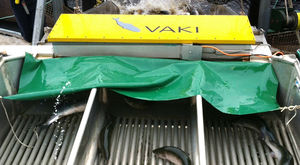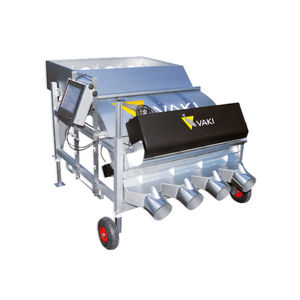
Bioscanner fish counting machine PLC1-channel4-channelfor aquaculture

Add to favorites
Compare this product
fo_shop_gate_exact_title
Characteristics
- Technology
- bioscanner
- Number of channels
- 1-channel, 4-channel
- Other characteristics
- for aquaculture, for salmon, for trout, connected, for tilapia
- Fish size range
Min.: 10 g
(0.4 oz)Max.: 11,000 g
(24.3 oz)- Capacity
Min.: 30 p/h
Max.: 50,000 p/h
Description
The VAKI Pipeline Counter (PLC) is installed in a pipeline from a grading machine or on the end of the pipe into a tank. Most often the PLC is being used for counting fish when being pumped either from a pen to a wellboat when delivering fish for harvesting, or when fish are pumped from one pen to another under grading or splitting of the cages. PLC can also be used at the outlet of a grading machine. The fish are counted as they pass through the counter using infra-red light beams that form a grid inside the scanner. For every fish pumped through the scanner, the grid is broken and an image of the fish is generated. The image is then used to count the fish.
The PLC is also available for Lumpfish.counters available.
ADVANTAGES
•Accurate counting.
•Easy to install / set up.
•Gentle on fish – fish in water at all times.
•Can be mounted directly to a grader / de-watering set up or on the end of the pipe from pump.
•Four scanners can be connected to the control unit.
•A robust technology for harsh environment.
Features
•Single channel display unit, powered by 12VDC.
•External 110/240V power supply available. IP66 waterproof.
•4 channel display unit, mains powered. IP66 waterproof.
•PC-based, 4 channel control unit with additional reporting and interfacing capabilities. IP65 waterproof.
VIDEO
Catalogs
No catalogs are available for this product.
See all of Vaki AS‘s catalogsRelated Searches
- Fish counting machine
- Aquaculture fish counting machine
- Fish grader
- Fish pump
- Salmon fish counting machine
- Trout fish counting machine
- Vacuum fish pump
- Salmon fish grader
- 1-channel fish counting machine
- Fry fish counting machine
- Self-priming fish pump
- 5-channel fish grader
- 8" fish pump
- 4-channel fish counting machine
- 6" fish pump
- 2-channel fish counting machine
*Prices are pre-tax. They exclude delivery charges and customs duties and do not include additional charges for installation or activation options. Prices are indicative only and may vary by country, with changes to the cost of raw materials and exchange rates.








